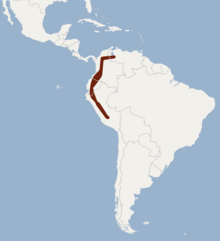| Bidentate yellow-shouldered bat | |
|---|---|
| Scientific classification | |
| Domain: | Eukaryota |
| Kingdom: | Animalia |
| Phylum: | Chordata |
| Class: | Mammalia |
| Order: | Chiroptera |
| Family: | Phyllostomidae |
| Genus: | Sturnira |
| Species: | S. bidens
|
| Binomial name | |
| Sturnira bidens (Thomas, 1915)
| |

| |
| Synonyms | |
| |
The bidentate yellow-shouldered bat (Sturnira bidens) is a species of bat in the family Phyllostomidae. It is found in South America.
Taxonomy and etymology
It was described as a new species in 1915 by British zoologist Oldfield Thomas. The holotype had been collected by Walter Goodfellow in April 1914 in Baeza, Ecuador. Thomas described a new, now-defunct genus, Corvira, giving the species the binomial of Corvira bidens.[2] The species name "bidens" is Latin for "two teeth;" of the bidentate yellow bat, Thomas wrote, "lower incisors only two."[2]
Description
It has a forearm length of 39.3–43.3 mm (1.55–1.70 in). It has a long and narrow snout and an overall narrow skull. It has a dental formula of 2.1.2.31.1.2.3 for a total of 30 teeth.[3]
Range and habitat
Its range includes Peru, Ecuador, Colombia, and Venezuela. It is found in association with the Andes Mountains at elevations of 1,700–3,000 m (5,600–9,800 ft).[1]
As of 2018, it was evaluated as a least-concern species by the IUCN, which is its lowest conservation priority.[1]
References
- ^ a b c Solari, S. (2018). "Sturnira bidens". IUCN Red List of Threatened Species. 2018: e.T20950A22052060. doi:10.2305/IUCN.UK.2018-2.RLTS.T20950A22052060.en. Retrieved 15 November 2021.
- ^ a b Thomas, Oldfield (1915). "XXXVI.—A new genus of phyllostome bats and a new Rhipidomys from Ecuador". Annals and Magazine of Natural History. 16 (94): 310–312. doi:10.1080/00222931508693718.
- ^ Gardner, A. L. (2008). Mammals of South America, Volume 1: Marsupials, Xenarthrans, Shrews, and Bats. Vol. 1. University of Chicago Press. p. 364–365. ISBN 978-0226282428.

